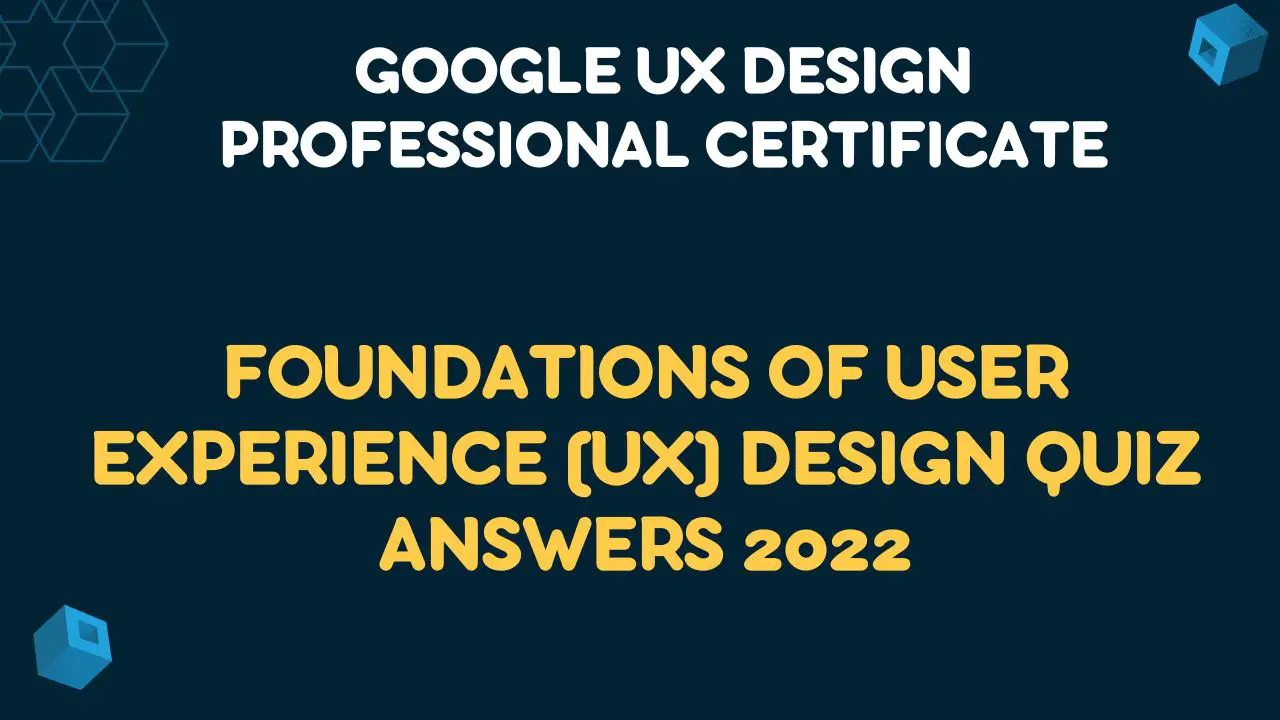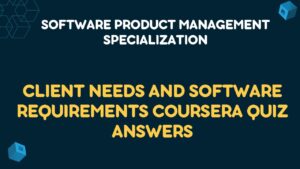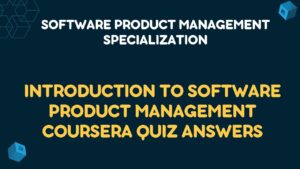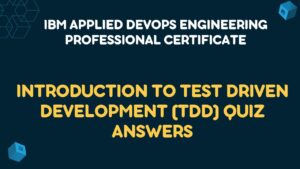Table of Contents
Get All Weeks Foundations of User Experience (UX) Design Quiz Answers
Test your knowledge of the roles you can pursue in UX design Quiz Answers
Q1. Fill in the blank: Hunter works at a startup as a user experience designer. Since Hunter is one of the only designers, she gets to oversee the majority of her UX processes. Throughout her work, Hunter discovers that she enjoys talking to users and testing designs more than actually designing things. For her next role, Hunter should consider becoming a _____.
- UX writer
- UX researcher
- Motion designer
- Interaction designer
Q2. Fill in the blank: Designers who work as freelancers can expect to _____.
- Work closely with a supervisor to learn more about a job or industry
- market their services to businesses to find customers
- receive on-the-job training from an experienced professional
- find short-term jobs with limited responsibility
Q3. What is an apprenticeship?
- A role with limited responsibilities that lasts a few months
- A role that provides on-the-job training and lasts between one to two years
- A role where a designer markets their services to businesses
- A role that requires several years of experience in the field
Foundations of User Experience (UX) Design Weekly Challenge 1 Answers
Q1. How does it benefit businesses to consider the user experience?
- It helps businesses copy successful product ideas from competitors in their market segment.
- It helps businesses create products that are usable and accessible to a wider range of customers.
- It helps businesses make design decisions based on business plans, rather than user preferences.
- It helps businesses limit spending on pricey user research studies, by focusing on design first.
Q2. What type of UX designer specializes in one kind of UX design, and has a breadth of knowledge in other areas?
- T-shaped
- Specialist
- Generalist
- Y-shaped
Q3. What does a visual designer do?
- Focus on how a product or technology looks.
- Focus on the experience of a product and how it functions.
- Focus on what it feels like for a user to move through a product.
- Focus on translating the design’s intent into a functioning experience.
Q4. Fill in the blank: If a user finds a product enjoyable to use, then the UX designer created a positive connection by considering the user’s ______ when making the product.
- personal background
- thoughts and feelings
- hobbies and interests
Q5. What are some of the day-to-day responsibilities of an entry-level UX designer? Select all that apply.
- Program management
- Wireframing
- Marketing
- Researching
Q6. Which type of UX designer dives deep into one particular role?
- Generalist
- Specialist
- Y-shaped
- T-shaped
Q7. Which type of business is most likely to hire a specialist designer?
- Startups
- Design agencies
- Large companies
- Small business
Q8. Alex is starting a career in UX and wants to work in a company with room for growth. Alex prefers a fast-paced, unstructured work environment. Which job is a good fit for Alex?
- Working at a design studio
- Working for a city government
- Working at a small startup
- Working for a large company
Q9. Which team member is responsible for translating a design into a functional product?
- Interaction designer
- Program Manager
- Engineer
- Production designer
Q10. Which of the options below is a common characteristic of internships?
- Internships are often short-term, lasting a few months, with limited responsibility.
- Internships generally last a long time, around one or two years.
- Internships allow you to work for yourself and market your services to find customers.
- Internships are always paid.
Foundations of User Experience (UX) Design Week 2 Quiz Answers
Test your knowledge on prioritizing the user Quiz Answers
Q1. Define the term user experience.
- User experience refers to how a person, the user, feels about interacting with or experiencing a product
- User experience refers to the specific audience a UX designer creates something for
- User experience refers to any person who uses a product
Q2. A bookstore’s design team builds a mobile app for educators who shop at their store. The app is designed to help educators track student performance, allowing them to reward high-performing students with books. Who are the end users of the product?
- Administrators
- Educators
- Students
- Caregivers
Q3. What are some key questions a designer can ask to evaluate user experience? Select all that apply.
- Is the product easy to use?
- Does the product meet sales and marketing goals?
- Does the product solve the user’s problem?
- Is the product equitable?
Test your knowledge of UX frameworks Quiz Answers
Q1. Identify the five elements of UX design framework. Select all that apply.
- Strategy
- Scope
- Skeleton
- Specify
- Structure
- Surface
Q2. What does the user-centered design framework focus on?
- User-centered design involves deep-diving into a particular role like interaction, visual, or motion design.
- User-centered design involves doing something again by building on previous versions and making adjustments.
- User-centered design involves taking an idea and creating a working product using the steps strategy, scope, structure, skeleton, and surface.
- User-centered design puts the focus on the user. In order to do so, UX designers must understand, specify, design, and evaluate during the design process.
Q3. Identify the steps involved in design thinking.
- Design thinking involves creating affordable and functional solutions that address problems that users face by empathizing, defining, ideating, prototyping, and testing.
- Design thinking involves understanding, designing, specifying, and evaluating in order to create a product that centers around the wants and needs of a user.
- Design thinking involves strategy, scope, structure, skeleton, and surface in order to turn an idea into a working product.
Test your knowledge on the importance of the Next Billion Users Quiz Answers
Q1. Who is considered the Next Billion Users in UX design?
- The Next Billion Users refers to people who are able to afford expensive phones with big screens and lots of storage.
- The Next Billion Users are people who are just starting to use the internet.
- The Next Billion Users refers to the amount of people who will drive cars in the coming years.
Q2. Name the major issues that the Next Billion Users face as they try to integrate into an increasingly digital world. Select all that apply.
- Connectivity
- Digital literacy
- Cost
- Literacy
- Testing
Q3. Which design approach should a UX designer consider for users with limited experience navigating websites?
- Colorful design with a variety of shapes and colors
- Complex and elaborate design
- Modern design with one or two colors
- Straightforward and simplistic design
Q4. If a user has a low level of digital literacy, what might they have trouble interpreting? Select all that apply.
- Design patterns
- Icons
- Word Pronunciation
- Calls to action
Test your knowledge of how UX designers think across platforms Quiz Answers
Q1. How is the term platform defined in UX design?
- A platform is the medium where users experience a product.
- A good, service, or feature
- A framework of a website or how it’s organized, categorized, and structured
- A platform is how a person, the user, feels about interacting with, or experiencing a product.
Q2. Consistency is important when designing a product across multiple platforms. What element should remain consistent regardless of which platform is used?
- Prototypes
- Brand identity
- Cost
- Responsive web design
Q3. Identify a few best practices to consider when designing websites for mobile users. Select all that apply.
- Simplify navigation
- Create brand-new gestures
- Place call-to-action buttons front and center
- Reduce visual clutter
Foundations of User Experience (UX) Design Weekly Challenge 2 Answers
Q1. Which of the following are common terms used by UX designers? Select all that apply.
- Key user
- User experience
- End-user
- User
Q2. A designer completes the first three steps of the user-centered design process. This results in a design they hope will solve the end user’s problem. What is the final step in the process?
- Evaluate
- Iterate
- Prototype
- Ideate
Q3. In which step do designers come up with ideas for what the product might look like?
- Understand
- Evaluate
- Design
- Specify
Q4. What is the purpose of a framework in UX design?
- Applies the design principles and best practices that can best support your end-user
- Share your proposed design solutions with stakeholders and developers
- Collects and synthesizes research on your end user’s wants, needs, and pain points
- Creates the basic structure that focuses and supports the problem you want to solve
Q5. At which stage does a designer assess how to organize a design and learn how the user will interact with the product?
- Surface
- Skeleton
- Strategy
- Scope
- Structure
Q6. When creating a product, it is important for designers to think about the user experience on different platforms, like desktop computers and mobile devices. What else should designers consider when thinking about platforms?
- How products will work cross-platform
- When backward compatibility should be prioritized over optimal design
- Which platforms control the largest market share
- How to optimize design for the designer’s preferred platform
Q7. What can a designer do to create a consistent brand identity across platforms? Select all that apply.
- Create a consistent visual appearance across platforms
- Establish a consistent company voice across platforms
- Design a custom app, to direct all users to a single platform experience
- Create unique color schemes for each platform.
Q8. Instead of building products for groups of people who are currently being excluded, what does an equity-focused design approach seek to do?
- Build products that meet the needs of specific individuals and groups who have been excluded in the past.
- Build products for users with the widest range of abilities and in the widest range of situations
- Build products for one type of user, so the benefits can extend to many other types of users.
Q9. Which of the following user experience design frameworks include strategy as a step?
- Design thinking
- Five elements of UX design
- User-centered design
Q10. Why should UX designers focus on the next billion users (NBU) in the design process?
- To design for a desktop-first audience, and adapt experiences to larger screens
- To design for current internet users, and create experiences to meet their needs
- To design for historically underrepresented user groups, and increase accessibility
- To design for future internet users, who are just getting online
Q11. Identify examples of assistive technology. Select all that apply.
- Alternative text
- Pencil
- Screen reader
- Color modification
Foundations of User Experience (UX) Design Week 3 Quiz Answers
Test your knowledge on design sprints Quiz Answers
Q1. How does a design sprint solve design challenges?
- They help designers choose the best design solution.
- They allow testing of the solution after launch.
- They allow unlimited time to make the best design decision.
- They begin with a solution in mind.
Q2. Which of the design sprint phases involves creating the first version of the proposed solution?
- Prototype
- Test
- Decide
- Understand
Q3. In phase three of a design sprint—the decide phase—what is the team’s goal?
- Build the first iteration of a product
- Brainstorm solutions
- Determine which solutions to build
- Assess the user problem
Q4. Why might a team consider conducting a design sprint? Select all that apply.
- To identify which design challenge to take on
- To develop cross-team strategies
- To define product directions
- To answer questions
Test your knowledge on planning a design sprint Quiz Answers
Q1. Why is it important to call in industry experts when planning a design sprint?
- Experts can help clarify the problem you’re trying to solve.
- Experts can test the product as a user.
- Experts can offer solutions for the design challenge.
- Experts can train designers in UX research.
Q2. A design sprint brief is a document that UX designers share with participants _____.
- to help them prepare for the design sprint
- to determine roles and responsibilities
- to provide a critique on the design
- to display the look and feel of a product
Q3. A design sprint brief should include the current state of the project and an estimated launch plan.
- True
- False
Test your knowledge on design sprint retrospectives Quiz Answers
Q1. Fill in the blank: Participating in a retrospective directly after a design sprint __________.
- allows users to give feedback directly to the sprint participants.
- ensures all sprint participants have the opportunity to give feedback.
- examines potential solutions to a design challenge.
- completes the UX design process.
Q2. New UX designers are involved in every stage of the decision-making process.
- True
- False
Q3. When do design sprint retrospectives usually take place?
- A couple weeks before a design sprint
- During a design sprint
- Immediately after a design sprint
- A few weeks after the design sprint
Foundations of User Experience (UX) Design Weekly Challenge 3 Answers
Q1. Which of the following should you ask in a design sprint retrospective? Select all that apply.
- What went well?
- Who will attend the next meeting?
- What is the next project?
- What can be improved?
Q2. Fill in the blank: In a design sprint retrospective, the team works together to review and critique what happened in the sprint _____.
- the team just finished
- the team will complete at project end (X)
- the team is currently completing (X)
- the team is about to start
Q3. Fill in the blank: When a design team reaches the final phase of a design sprint, they can _____.
- identify design challenges
- implement design feedback (X)
- code their designs
- test their prototype
Q4. Which of the following are important phases of the design sprint process?
- Planning and implementing
- Development and retrospective
- Understanding and ideating
Q5. Select the statement that best describes design sprint planning.
- By talking to the experts, looking at the feedback from customers, gathering a team, and working through a solution, we are better able to provide an enjoyable user experience that meets the business’s objectives.
- By listening to stakeholders and looking at our competitors, we can prevent making the same mistakes, create or improve upon existing features, and build a better product.
- Finding a good team and a project sponsor are the most important steps in planning a successful design sprint and creating a better-improved product for end-users.
Q6. As an entry-level UX designer, my role in design sprint planning is to set goals.
- True
- False
Q7. When in the design sprint does the design team create a prototype?
- Before the test phase, and after the decision phase
- Before the decide phase, and after the test phase
- During the ideate phase
- During the understanding phase
Q8. Do design sprints help teams prioritize a profit-driven path to market for their designs?
- Yes. Design sprints prioritize a design’s fiscal viability. They help teams identify a profit-driven path to market.
- No. Design sprints prioritize the user. They help teams create a path to market, but they put the user before profit.
- Sometimes. Design sprints may help teams identify a profit-driven path to market. The team needs to choose between a user-first approach and a profit-first approach.
Q9. In this step of planning a design sprint, you create icebreakers relevant to the sprint to motivate your team, put them in the right mindset, and help them get comfortable with each other.
- Call in the experts
- Establish sprint rules
- Gather supplies
- Plan introductions
Q10. What is a design sprint brief?
- A process to come up with ideas and build off of them to generate solutions
- A collaborative critique of a team’s design sprint
- A document that UX designers share with participants to help them prepare for the design sprint
- A process occurring in five phases to solve critical design challenges
Foundations of User Experience (UX) Design Week 4 Quiz Answers
Test your knowledge of UX design portfolios Quiz Answers
Q1. How does a portfolio help UX designers find work in their field? Select all that apply.
- A portfolio can highlight a UX designer’s skills during the job application process.
- A portfolio includes a 1-page summary on why a designer would be a good fit for an open position.
- A portfolio showcases a designer’s understanding of UX design principles.
Q2. What is a design portfolio?
- A collection of social media posts that demonstrate a designer’s work history
- A collection of work that demonstrates a designer’s skills during the job application process
- A collection of design work that includes the top designers in a field
- A collection of professional references complete with phone numbers
Test your knowledge on building an online presence Quiz Answers
Q1. Fill in the blank: A _______ is a one- or two-sentence phrase that describes what you do and what you stand for.
- personal brand
- personal statement
- tagline
Q2. How can your presence in online design communities help you gain exposure to UX design? Select all that apply.
- You can post your designs and receive feedback from experienced UX designers.
- You can engage with other UX designers by liking or commenting on their community posts.
- You can follow the profiles of non-UX design professionals.
Q3. Why do recruiters check your social media profiles when considering you for a job? Select all that apply.
- To test your knowledge of UX design
- To learn about your interests outside of work
- To assess if you have a strong professional network
- To confirm your work and educational background
Foundations of User Experience (UX) Design Weekly Challenge 4 Answers
Q1. Why is it important for UX designers to use a portfolio during the job application process?
- Because it shows hiring managers examples of work and the skills a designer can bring to the job
- Because it’s a great way to start feeling like a part of the UX design community
- Because jobs in the creative fields don’t accept traditional resumes
Q2. What is the benefit of using a website builder?
- Website builders offer tutorials on building with code.
- Website builders make it possible to create a functional website without HTML and CSS knowledge.
- Website builders have a single template.
- Website builders are only for advanced users.
Q3. When including case studies in a design portfolio, which of the following questions should they answer?
- What biases did the designer include?
- Who were the designer’s mentors?
- What UX design online communities are featured in the case study?
- What process did the designer follow?
Q4. Personal branding is essential to demonstrating a designer’s values, unique skills, and personality. What are the benefits of creating a personal brand? Select all that apply.
- A personal brand allows recruiters and potential employers to understand who you are, and learn about your passions and your strengths.
- A personal brand helps you stand out from the crowd.
- A personal brand allows you to blend in with the rest of the design community.
- A personal brand can help you match with companies that share your values.
Q5. How can a designer reinforce their professional presence online?
- Keep their design style, professional photos, and personal brand consistent across platforms.
- Post exclusive content on their preferred social media platform.
- Post personal opinions about non-industry subjects.
- Curate a company’s statement that reflects their brand and work.
Q6. Which of the following can help a UX designer enhance their social media presence?
- Avoid starting conversations with industry professionals on social media
- Don’t worry about what is shared, posted, and liked on social media
- Tag and interact with industry professionals on social media
- Set personal accounts to public mode.
Q7. Identify websites that feature a job board to assist designers in procuring their next job or project. Select all that apply.
- Dribbble
- Behance
- Medium
Q8. What should a designer include in their application for a design role?
- Personal social media profiles
- Resume
- Design inspirations
- Hobbies and interests
Q9. How can designers benefit from online UX communities?
- Get inspiration from other designers
- Start a design business and file key legal documents
- Share full case studies
- Communicate with company executives
Q10. Consider the following scenario:
A UX designer wants to create an updated portfolio to showcase their unique skills and values as a designer. They start by purchasing a custom domain name. To make a great first impression on website visitors, they add projects that highlight the type of work they do well. Then, they add a concise description of their personal design philosophy to help them stand out from the crowd.
This designer is applying what best practices to convey the value of their work.
- Establish a personal brand
- Tell a complex and detailed story
- Use widely available templates
- Leverage free online resources
Q11. Imagine that a designer writes content for their online portfolio. To align with their personal brand, they include friendly, conversational language. They write brief and snappy descriptions and include key details about their professional background. Before they publish, what can they do to ensure the content is as good as it can be?
- Complement written content with visual components
- Add long descriptive paragraphs to hook readers
- Infuse buzzwords and technical terms into the written content
- Find a trusted editor to review the content
Q12. Imagine a designer is creating a portfolio and needs to write an introduction. Which of the following is an example best practice of an introduction?
- “Hi, I’m Jenna. I believe the user is the center of any successful design solution.”
- “I like to create user-centered design experiences for underrepresented audiences.”
- “Hello, I’m Jenna. It’s a pleasure to meet you.”
Get started in the fast-growing field of user experience (UX) design with the Google UX Design professional certificate. Learn the foundations of UX design, including empathizing with users, building wireframes and prototypes, and conducting research to test your designs.
Get Google UX Design Professional Certificate Course Quiz Answers
Foundations of User Experience (UX) Design Quiz Answers
Start the UX Design Process: Empathize, Define, and Ideate Quiz Answers
Build Wireframes and Low-Fidelity Prototypes Quiz Answers
Conduct UX Research and Test Early Concepts Quiz Answers
Create High-Fidelity Designs and Prototypes in Figma Quiz Answers
Responsive Web Design in Adobe XD Quiz Answers
Design a User Experience for Social Good & Prepare for Jobs Quiz Answers





